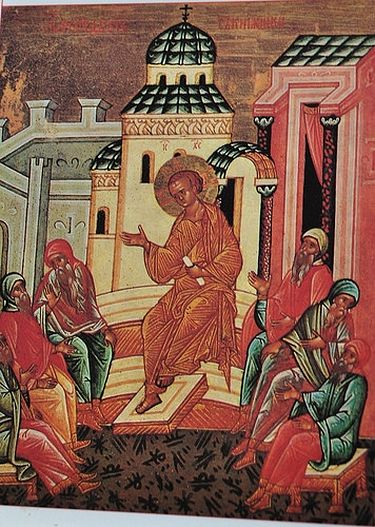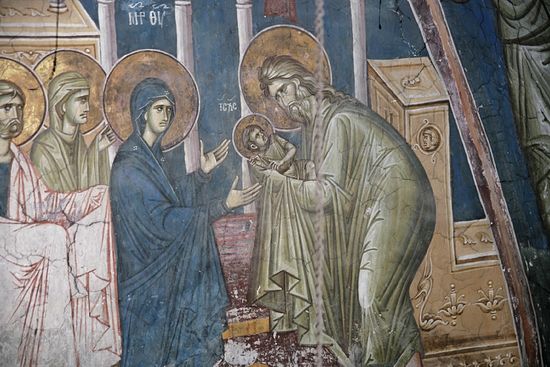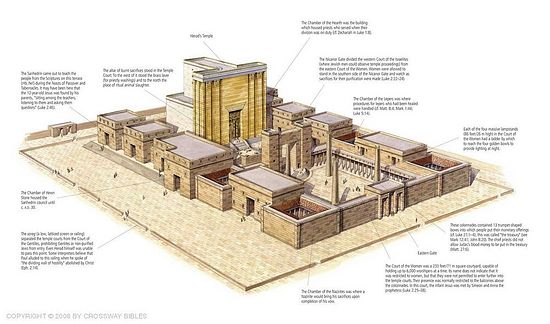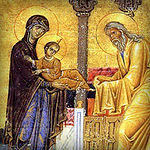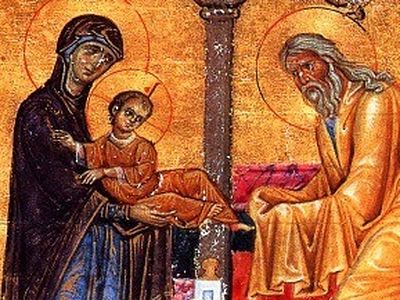February 2nd on the Orthodox Church Calendar is the Feast of the Meeting of our Lord in the Temple. The Feast commemorates the events described in Luke 2:22-40.
It is 40 days after the Nativity of Christ, and His parents, Mary and Joseph, bring the infant Jesus into the Jerusalem Temple in fulfillment of the Torah commandments concerning the birth of a son. The Feast celebrates the fulfilling of the Torah concerning the Temple’s role in salvation and also celebrates Christ being THE High Priest of God forever. Christ fulfills and supersedes both the Temple and the Levitical Priesthood in beginning the New Covenant.
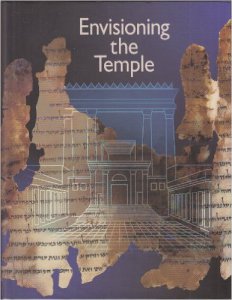
1] The Temple in Jerusalem, like the Tabernacle in the Desert, was to be made according to a heavenly model which was revealed first to Moses and then to King David.
“As related in the Bible, the initiative for the construction of the Tabernacle in the desert came from on high: when Moses was on Mount Sinai for forty days and forty nights, God commanded, ‘And let them make Me a sanctuary that I may dwell among them. Exactly as I show you – the pattern of the Tabernacle and the pattern of all its furnishings – so shall you make it’ (Exod 25:8-9). [footnote – Note that underlying this account is the assumption that the desert Tabernacle was built according to a heavenly prototype.]” (p 49)
“Significantly, David, like Moses at Sinai (cf. Exod 25:9), was said to have received a ‘blueprint’ in God’s own hand (1 Chron 28:19). [footnote: In antiquity people clearly believed that earthly temples were built on the basis of a transcendental, heavenly, prototype.]” (p 50)
The fact that the earthly Temple was meant to be built in the image of a heavenly prototype allows for a number of interesting comparisons.
A) The Temple in some way was thought to imitate Paradise, which was the image used by God to construct the world in the beginning. God was building Himself a Temple when He created Paradise and earth – a place to reside within His creation.
B) Christ is thought to be in some form the real Temple, of which the Jerusalem Temple and the desert Tabernacle were simply shadowy images. When Christ appears in the Temple, the purpose of the Temple is fulfilled and it reveals the Christ who is the real dwelling place of God on earth. What Solomon built was a temple based on a blueprint, but with the arrival of Christ, we have the real temple of God and no longer are in need of a blueprint.
C) The Theotokos is also portrayed as the living Temple in as much as she is God’s dwelling place on earth.
D) Christians, the Church, are to be the living Temple, replacing the need for a building of stone and bricks. Christians did not bemoan the destruction of the Jerusalem Temple by the Romans in 70AD, for they believed the true Temple was eternal and had already been raised up!
2] The temple is all about holiness/separation:
“In sum, the anonymous architect intended to protect the House of God from any contact with impurity and to enhance its sanctity by means of the three concentric courts and the moat around them. The source of sanctity, where God’s Presence would reside – the Temple – would stand in the center of the inner court, radiating its holiness to the whole of the Jewish people and the land of Israel, just as at the time of the Israelite’s wanderings in the desert.” (p 45)
The holiness of Israel comes from God. The Temple is made holy by God’s presence there. So too it is Christ, God incarnate, who brings holiness to the Temple, and makes the people of God Holy.
“In the biblical account, the Tabernacle had three main roles. To begin with, it provided a place for God to ‘dwell among the Israelites‘ (Exod 25:8; 29:45-46). It was also a cultic space in which, for example, a daily burnt-offering was sacrificed twice a day (ibid. 29:38-43)… Finally, it was in the Tabernacle – the ‘Tent of the Meeting‘ – that the Divine Presence revealed itself to Moses (ibid. 25:22; 30:6). ” (p 50)
There is a very important connection between the Tent/ Tabernacle of the meeting and the meeting of the Lord in the Temple. The Feast celebrates the fulfillment of all the Temple was intended to be. When the Christ child, the incarnate God, enters the temple, the Divine Presence is in the Temple and the purpose of the Temple is fulfilled.
3] The Temple is God’s dwelling place on earth.
“According to ancient beliefs, the main purpose of Solomon’s Temple was to provide an earthly dwelling place for God. This is clearly demonstrated by the account in the first book of Kings of the Ark of the Covenant being brought into the Holy of Holies: ‘. . . the cloud had filled the House of the Lord and the priests were not able to remain and perform the service because of the cloud, for the Presence of the Lord filled the House of the Lord’ (8:10-11). [footnote: However, this idea is deliberately revised in the present text of 1 Kings. In Solomon’s prayer… the possibility that God could dwell in the Temple is emphatically rejected (8:27). The text states that only God’s ‘name‘ dwells in the Temple (v. 29); the actual ‘abode‘ of the Almighty is in heaven (vv. 39, 43, etc.). The conception of the Temple’s primary purpose therefore changes accordingly, and the focus is no longer on the sacrifices, but on the prayers that will be offered up (vv. 28ff).] (p 53)
We see in the above what is often true in the Holy Scriptures: there is often a tension between conflicting ideas about God. This is no doubt intentional in the Scriptures to help prevent us from being overly literal in our reading of the text. The Temple is the dwelling place for God and/or the Temple is the place where God’s Name dwells on earth. God is both imminent and transcendent. This truly is fulfilled in the incarnation in which Christ is both fully human and fully God. Christ walks on earth and yet never ceases to reside with God in heaven.
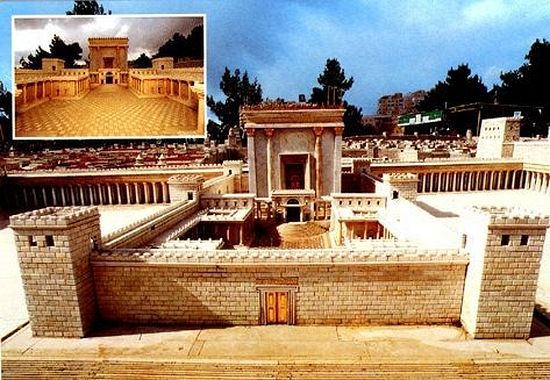
4] Christ the eschatological Temple.
“In the last part of the book of Ezekiel … (Ezekiel 38-39), the prophet describes the future restoration of the people of Israel to its land, including an eschatological vision of the Temple and its cult (chaps. 40-48). The prophet’s guiding principle is the necessity for an entirely new Temple, free of any impurity and quite different from the unclean Temple that stood in Jerusalem prior to the destruction of 586 BCE (see Ezek 43:1-12; 434:6-8). . . . Ezekiel’s Temple no longer houses the Ark of the Covenant that occupied the heart of Solomon’s Temple; instead, the ‘Presence of the Lord’ fills the Temple (43:4-5). This is God’s abode: ‘. . . It said to me: O mortal, this is the place of My throne and the place for the soles of My feet, where I will dwell in the midst of the people Israel forever. …’ (Ezek 43:7). The prophet’s eschatological Temple will thus resemble the Tabernacle in the wilderness, built in fulfillment of the Divine command,‘And let them make Me a sanctuary that I may dwell among them’ (Exod 25:80).” (pp 53, 55)
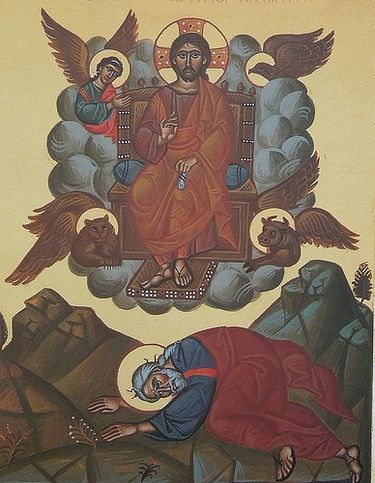 Ezekiel’s vision
Ezekiel’s vision
We can note the literal fulfillment of what God says to Ezekiel that the Temple is “the place for the soles of My feet”. In the Meeting of the Lord, God is present in the soles of the feet of the infant Jesus. This is an unexpected literal fulfillment of what God promised!
It is not the Ark of the Covenant and the Ten Commandments which represent the Divine Presence in the Temple. For now Christ, the incarnate God, dwells in the Temple. Christ dwells in the Temple and is Himself the pure Temple of God. So too the Virgin Mary is portrayed in the same way as the Pure Temple of God prophesied by Ezekiel. Thus all that God promised and prophesied in the Jewish Scriptures come to fulfillment in Christ.
